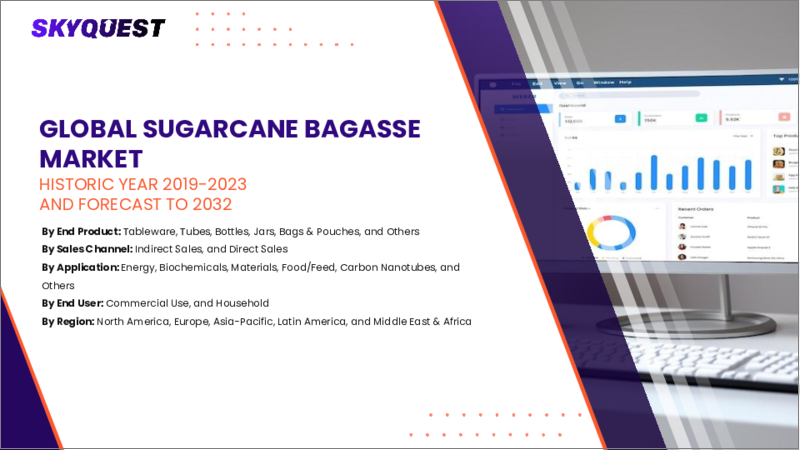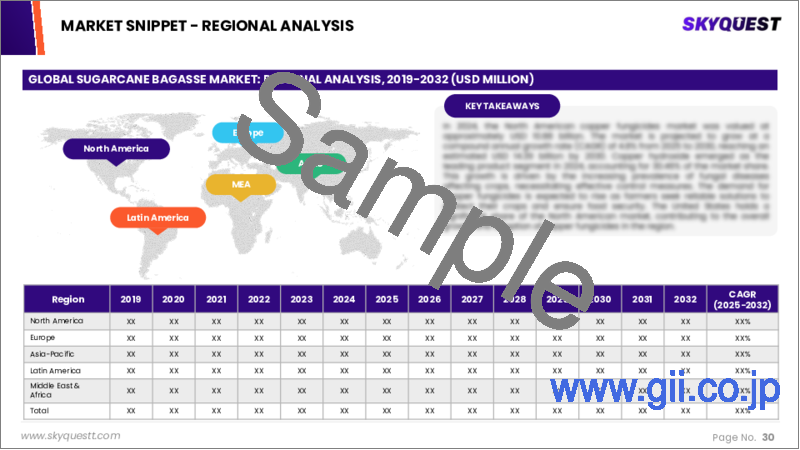|
|
市場調査レポート
商品コード
1624109
サトウキビバガスの市場規模、シェア、成長分析、販売チャネル別、用途別、エンドユーザー別、地域別-産業予測、2025~2032年Sugarcane Bagasse Market Size, Share, Growth Analysis, By Sales Channel (Indirect Sales, Direct Sales), By Application (Energy, Biochemicals), By End User, By Region - Industry Forecast 2025-2032 |
||||||
|
|||||||
| サトウキビバガスの市場規模、シェア、成長分析、販売チャネル別、用途別、エンドユーザー別、地域別-産業予測、2025~2032年 |
|
出版日: 2025年01月03日
発行: SkyQuest
ページ情報: 英文 249 Pages
納期: 3~5営業日
|
全表示
- 概要
- 目次
サトウキビバガスの世界市場規模は、2023年に9億4,230万米ドルと評価され、2024年の9億8,093万米ドルから2032年には13億5,284万米ドルに成長し、予測期間中(2025~2032年)のCAGRは4.1%で成長する見通しです。
予測されるバガス利用可能量の増加は、サトウキビが依然として主要な砂糖源であることから、世界の砂糖需要の急増に起因しています。しかし、砂糖の生産は、固形廃棄物、廃水、排出物による著しい環境汚染に関連しています。産業バイオテクノロジーの進歩を活用し、サトウキビ産業の製品別であるバガスは、農業産業廃棄物を利用する経済的機会を提供します。セルロースが約50%、ヘミセルロースとリグニンがそれぞれ25%含まれるバガスは、タンパク質を強化した飼料、酵素、有機酸などの貴重な製品を生産する微生物プロセスの基質として効果的に利用できます。バガスは、他の作物に比べて灰分が非常に少なく、1ヘクタール当たり約80トンという高いバイオマス収量を誇るため、バイオコンバージョンプロセスや持続可能な廃棄物管理を強化するための有望な候補です。
目次
イントロダクション
- 調査の目的
- 調査範囲
- 定義
調査手法
- 情報調達
- 二次データと一次データの方法
- 市場規模予測
- 市場の前提条件と制限
エグゼクティブサマリー
- 世界市場の見通し
- 供給と需要の動向分析
- セグメント別機会分析
市場力学と見通し
- 市場概要
- 市場規模
- 市場力学
- 促進要因と機会
- 抑制要因と課題
- ポーターの分析
主な市場の考察
- 重要成功要因
- 競合の程度
- 主な投資機会
- 市場エコシステム
- 市場の魅力指数(2024年)
- PESTEL分析
- マクロ経済指標
- バリューチェーン分析
- 価格分析
サトウキビバガスの市場規模:販売チャネル別& CAGR(2025-2032)
- 市場概要
- 間接販売
- 直接販売
サトウキビバガスの市場規模:用途別& CAGR(2025-2032)
- 市場概要
- エネルギー
- 生化学物質
- 原料
- 食品/飼料
- カーボンナノチューブ
- その他
サトウキビバガスの市場規模:エンドユーザー別& CAGR(2025-2032)
- 市場概要
- 商用利用
- 家庭用
サトウキビバガスの市場規模:地域別& CAGR(2025-2032)
- 北米
- 米国
- カナダ
- 欧州
- ドイツ
- スペイン
- フランス
- 英国
- イタリア
- その他欧州地域
- アジア太平洋地域
- 中国
- インド
- 日本
- 韓国
- その他アジア太平洋地域
- ラテンアメリカ
- ブラジル
- その他ラテンアメリカ地域
- 中東・アフリカ
- GCC諸国
- 南アフリカ
- その他中東・アフリカ
競合情報
- 上位5社の比較
- 主要企業の市場ポジショニング(2024年)
- 主な市場企業が採用した戦略
- 市場の最近の動向
- 企業の市場シェア分析(2024年)
- 主要企業の企業プロファイル
- 会社概要
- 製品ポートフォリオ分析
- セグメント別シェア分析
- 収益の前年比比較(2022-2024)
主要企業プロファイル
- Raizen(Brazil)
- Cosan S.A.(Brazil)
- Sudzucker AG(Germany)
- Tereos(France)
- Wilmar International Limited(Singapore)
- Thai Roong Ruang Sugar Group(Thailand)
- Mitr Phol Sugar Corp., Ltd.(Thailand)
- Shree Renuka Sugars Limited(India)
- Balrampur Chini Mills Limited(India)
- Sugarmade, Inc.(USA)
- Bio Futura B.V.(Netherlands)
- Pactiv Evergreen Inc.(USA)
- Green Paper Products(USA)
- Enerkem Inc.(Canada)
- GranBio(Brazil)
- APP(Asia Pulp & Paper)Sinar Mas(Indonesia)
- Xinyang Paper Industry Co., Ltd.(China)
結論と推奨事項
Global Sugarcane Bagasse Market size was valued at USD 942.3 million in 2023 and is poised to grow from USD 980.93 million in 2024 to USD 1352.84 million by 2032, growing at a CAGR of 4.1% during the forecast period (2025-2032).
The anticipated increase in bagasse availability stems from surging global sugar demand, as sugarcane remains the primary sugar source. However, sugar production is associated with significant environmental pollution due to solid waste, wastewater, and emissions. Leveraging advancements in industrial biotechnology, the sugarcane industry's by-product, bagasse, presents economic opportunities for utilizing agro-industrial waste. Comprising roughly 50% cellulose and 25% each of hemicellulose and lignin, bagasse can effectively serve as a substrate for microbial processes that produce valuable products such as protein-enriched animal feed, enzymes, and organic acids. With its exceptionally low ash content and high biomass yield-about 80 tonnes per hectare-compared to other crops, bagasse is a promising candidate for enhancing bioconversion processes and sustainable waste management.
Top-down and bottom-up approaches were used to estimate and validate the size of the Global Sugarcane Bagasse market and to estimate the size of various other dependent submarkets. The research methodology used to estimate the market size includes the following details: The key players in the market were identified through secondary research, and their market shares in the respective regions were determined through primary and secondary research. This entire procedure includes the study of the annual and financial reports of the top market players and extensive interviews for key insights from industry leaders such as CEOs, VPs, directors, and marketing executives. All percentage shares split, and breakdowns were determined using secondary sources and verified through Primary sources. All possible parameters that affect the markets covered in this research study have been accounted for, viewed in extensive detail, verified through primary research, and analyzed to get the final quantitative and qualitative data.
Global Sugarcane Bagasse Market Segmental Analysis
Global Sugarcane Bagasse Market is segmented by Sales Channel, Application, End User and region. Based on Sales Channel, the market is segmented into Indirect Sales and Direct Sales. Based on Application, the market is segmented into Energy, Biochemicals, Materials, Food/Feed, Carbon Nanotubes and Others. Based on End User, the market is segmented into Commercial Use and Household. Based on region, the market is segmented into North America, Europe, Asia Pacific, Latin America and Middle East & Africa.
Driver of the Global Sugarcane Bagasse Market
The global sugarcane bagasse market is significantly driven by its versatile applications. Bagasse is primarily utilized as a fuel source, generating steam and electricity for sugar mills, which typically need around 35 kWh and 450 kg of exhaust steam per tonne of processed cane. Modern sugar mills have optimized these requirements to approximately 30 kWh and 300 kg of steam, enabling them to operate more efficiently while saving up to 50% of the generated bagasse. This surplus can be harnessed to produce grid power or serve as a raw material for various products, including high-quality paper and board. However, challenges such as the capital-intensive nature of paper production, the treatment of wastewater, and the need for a sizeable internal market still persist.
Restraints in the Global Sugarcane Bagasse Market
The global Sugarcane Bagasse market faces significant restraints, primarily due to the challenges associated with the long-term storage of large quantities of bagasse for off-season electricity generation. Unlike small-scale storage or the wet storage required for pulp and paper production, large-scale storage presents unique issues, including the deterioration of fuel value, risks of spontaneous combustion, and complications in handling the bagasse. Furthermore, the substantial waste generated by the sugarcane industry, particularly in leading nations like Brazil and India, raises serious environmental and health concerns. These factors hinder the market's potential expansion, necessitating effective management strategies to address these challenges.
Market Trends of the Global Sugarcane Bagasse Market
The global sugarcane bagasse market is witnessing a notable trend driven by innovative applications across various sectors. Increasing recognition of bagasse as a versatile byproduct has led to its enhanced usage in materials science, particularly in agriculture as a natural soil conditioner, and in construction for improving durability and mechanical properties of building materials. Furthermore, the textile industry is integrating bagasse fibers for sustainable fabric production, while the environmental sector capitalizes on its adsorbent capabilities for wastewater treatment. The recent exploration of bagasse as a raw material for carbon quantum dots indicates its potential in technology, including biosensors and medical applications, showcasing the market's expansion and diversification.
Table of Contents
Introduction
- Objectives of the Study
- Scope of the Report
- Definitions
Research Methodology
- Information Procurement
- Secondary & Primary Data Methods
- Market Size Estimation
- Market Assumptions & Limitations
Executive Summary
- Global Market Outlook
- Supply & Demand Trend Analysis
- Segmental Opportunity Analysis
Market Dynamics & Outlook
- Market Overview
- Market Size
- Market Dynamics
- Drivers & Opportunities
- Restraints & Challenges
- Porters Analysis
- Competitive rivalry
- Threat of substitute
- Bargaining power of buyers
- Threat of new entrants
- Bargaining power of suppliers
Key Market Insights
- Key Success Factors
- Degree of Competition
- Top Investment Pockets
- Market Ecosystem
- Market Attractiveness Index, 2024
- PESTEL Analysis
- Macro-Economic Indicators
- Value Chain Analysis
- Pricing Analysis
Global Sugarcane Bagasse Market Size by Sales Channel & CAGR (2025-2032)
- Market Overview
- Indirect Sales
- Direct Sales
Global Sugarcane Bagasse Market Size by Application & CAGR (2025-2032)
- Market Overview
- Energy
- Biochemicals
- Materials
- Food/Feed
- Carbon Nanotubes
- Others
Global Sugarcane Bagasse Market Size by End User & CAGR (2025-2032)
- Market Overview
- Commercial Use
- Household
Global Sugarcane Bagasse Market Size & CAGR (2025-2032)
- North America (Sales Channel, Application, End User)
- US
- Canada
- Europe (Sales Channel, Application, End User)
- Germany
- Spain
- France
- UK
- Italy
- Rest of Europe
- Asia Pacific (Sales Channel, Application, End User)
- China
- India
- Japan
- South Korea
- Rest of Asia-Pacific
- Latin America (Sales Channel, Application, End User)
- Brazil
- Rest of Latin America
- Middle East & Africa (Sales Channel, Application, End User)
- GCC Countries
- South Africa
- Rest of Middle East & Africa
Competitive Intelligence
- Top 5 Player Comparison
- Market Positioning of Key Players, 2024
- Strategies Adopted by Key Market Players
- Recent Developments in the Market
- Company Market Share Analysis, 2024
- Company Profiles of All Key Players
- Company Details
- Product Portfolio Analysis
- Company's Segmental Share Analysis
- Revenue Y-O-Y Comparison (2022-2024)
Key Company Profiles
- Raizen (Brazil)
- Company Overview
- Business Segment Overview
- Financial Updates
- Key Developments
- Cosan S.A. (Brazil)
- Company Overview
- Business Segment Overview
- Financial Updates
- Key Developments
- Sudzucker AG (Germany)
- Company Overview
- Business Segment Overview
- Financial Updates
- Key Developments
- Tereos (France)
- Company Overview
- Business Segment Overview
- Financial Updates
- Key Developments
- Wilmar International Limited (Singapore)
- Company Overview
- Business Segment Overview
- Financial Updates
- Key Developments
- Thai Roong Ruang Sugar Group (Thailand)
- Company Overview
- Business Segment Overview
- Financial Updates
- Key Developments
- Mitr Phol Sugar Corp., Ltd. (Thailand)
- Company Overview
- Business Segment Overview
- Financial Updates
- Key Developments
- Shree Renuka Sugars Limited (India)
- Company Overview
- Business Segment Overview
- Financial Updates
- Key Developments
- Balrampur Chini Mills Limited (India)
- Company Overview
- Business Segment Overview
- Financial Updates
- Key Developments
- Sugarmade, Inc. (USA)
- Company Overview
- Business Segment Overview
- Financial Updates
- Key Developments
- Bio Futura B.V. (Netherlands)
- Company Overview
- Business Segment Overview
- Financial Updates
- Key Developments
- Pactiv Evergreen Inc. (USA)
- Company Overview
- Business Segment Overview
- Financial Updates
- Key Developments
- Green Paper Products (USA)
- Company Overview
- Business Segment Overview
- Financial Updates
- Key Developments
- Enerkem Inc. (Canada)
- Company Overview
- Business Segment Overview
- Financial Updates
- Key Developments
- GranBio (Brazil)
- Company Overview
- Business Segment Overview
- Financial Updates
- Key Developments
- APP (Asia Pulp & Paper) Sinar Mas (Indonesia)
- Company Overview
- Business Segment Overview
- Financial Updates
- Key Developments
- Xinyang Paper Industry Co., Ltd. (China)
- Company Overview
- Business Segment Overview
- Financial Updates
- Key Developments





